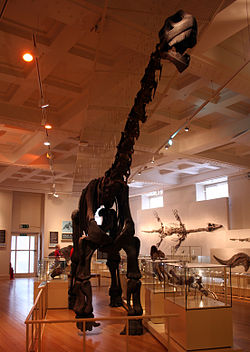Cetiosaur
|
Cetiosaurus Temporal range: Middle Jurassic, 167 Ma |
|
|---|---|
 |
|
| Mounted skeleton, New Walk Museum | |
| Scientific classification | |
| Kingdom: | Animalia |
| Phylum: | Chordata |
| Clade: | Dinosauria |
| Order: | Saurischia |
| Suborder: | †Sauropodomorpha |
| Clade: | †Sauropoda |
| Family: | †Cetiosauridae |
| Genus: |
†Cetiosaurus Owen, 1841 |
| Species: | †C. oxoniensis |
| Binomial name | |
|
Cetiosaurus oxoniensis Phillips, 1871 |
|
Cetiosaurus (SEET-ee-oh-sawr-us) meaning 'whale lizard', from the Greek keteios/κήτειος meaning 'sea monster' (later, 'whale') and sauros/σαυρος meaning 'lizard', is a herbivorous sauropod dinosaur from the Middle Jurassic Period, living about 167 million years ago in what is now Europe.
Cetiosaurus was in 1842 the first sauropod from which bones were described and is the most complete sauropod found in England. It was so named because its describer, Sir Richard Owen, supposed it was a marine creature, initially an extremely large crocodile, and did not recognise it for a land-dwelling dinosaur. Because of the early description many species would be named in the genus, eventually eighteen of them. Most of these have now been placed in other genera or are understood to be dubious names, based on poor fossil material. The last is true also of the original type species, Cetiosaurus medius, and so C. oxoniensis was officially made the new type species in 2014. C. oxoniensis is based on three more or less complete specimens, discovered from 1868 onwards. Together they contain most of the bones, with the exception of the skull.
Cetiosaurus oxoniensis was a "primitive", quadrupedal, long-necked, small-headed herbivore. It had a shorter tail and neck than most sauropods. The forelimbs on the other hand, were relatively long. C. oxoniensis is estimated to have been about 16 metres (52 ft) long and to have weighed roughly 11 tonnes (12 short tons).
Cetiosaurus was, with the exception of the tooth genus Cardiodon, the first sauropod to be discovered and named as well as being the best known sauropod from England. Numerous species have been assigned to Cetiosaurus over the years belonging to several different groups of sauropod dinosaurs. The genus thus functioned as a typical "wastebasket taxon". Fossilized remains once assigned to Cetiosaurus have mainly been found in England but also in France, Switzerland and Morocco.
...
Wikipedia
